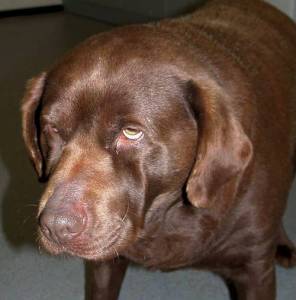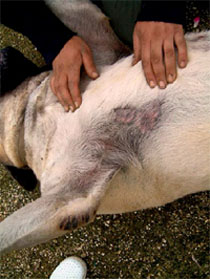
Hypothyroidism
A page about hypothyroidism in dogs describing cause, clinical signs, diagnosis and control.
Introduction
Hypothyroidism is manifest as low circulating thyroid hormone (total thyroxine or tT4) concentrations in blood. Levels are only an indication of deficiency as most of the thyroid hormone in the body is stored.

Aetiology
Primary disease is caused by a deficiency of thyroid hormone production by the thyroid gland (incriminated in over 95% cases). Secondary disease is due to a deficiency of thyroid hormone for other reasons (including lack of thyroid stimulating hormone (TSH), produced by the pituitary gland in the brain due to a congenital disorder (birth defect) or a brain (pituitary) tumor. In lymphocytic thyroiditis antibodies are generated against the thyroid gland cells and lead to destruction of the thyroid gland. Clinical hypothyroidism develops after about 75% of the thyroid gland is destroyed (1-3 years to progress). There is also a form of hypothyroidism which is of unknown cause (idiopathic). In idiopathic hypothyroidism, atrophy (shrinkage) of the cells of the thyroid gland occurs and they are replaced by fat cells.

Epidemiology
The disease affects about 0.3% of dogs though it is very rare in cats (except following surgery or radiotherapy for hyperthyroidism). It most commonly affects dogs > 4 years old. Some breeds appear to be over-represented particularly those prone to autoimmune lymphocytic thyroiditis including dogs of the following breeds: Airedale, Akita, Beagle, Boxer, Collies and other sheepdogs, Dachshund, Dalmations, Dobermans, Husky, Pomeranian, Setters, Mini Schnauzer, Cocker Spaniels, Rhodesian Ridgebacks amongst others.
Clinical Signs
Initial diagnosis can be challenging as signs are often vague at onset. Dogs with hypothyroidism are often described to have a tragic facial expression due to a puffy face or dropping of the upper eyelids. There is increased shedding of hair and the coat is often dry, coarse, thin or sparse. Furthermore there is a lack of hair regrowth, e.g. after clipping and hair loss can be associated with dry and flaky skin (dandruff), that is not usually itchy. Dogs may also develop a “rat tail” due to hair loss in that region. There may also be noticeable thickening and darkening of the skin (hyperpigmentation), especially on the belly and the inner surface of the hind legs. Lethargy, weight gain, seeking warmth and bradycardia are common clinical findings.

Diagnosis
A diagnosis of hypothyroidism can be made based on clinical signs in conjunction with the following lab tests:
The first test to use is to measure Total thyroxine (tT4). If this is low, then evaluate if the animal is on T4 suppressing drugs or has evidence of another non-thyroidal systemic disease. If neither of these are the case it is worth running a thyroid function test. If Thyroid Stimulating Hormone (cTSH, thyrotropin) levels are normal / high (cTSH ≥ 0.68 ng/mL) AND Free thyroxine by equilibrium dialysis (fT4d) is low (fT4d ≤ 5.4 pmol/L) then the animal is hypothyroid. If Thyroid Stimulating Hormone (cTSH, thyrotropin) levels are normal AND Free thyroxine by equilibrium dialysis (fT4d) is normal then the animal is euthyroid (thyroid gland is normal).
Thyroglobulin antibodies (TGAA) may be measured to determine if the animal is suspected to have autoimmune thyroiditis. If TSH levels are elevated they should be re-evaluated in 8-12 weeks.

Control
Thyroid hormone replacement therapy is the best approach to treating hypothyroidism. Effecting a cure needs good compliance with the dosing regimen. A variety of formulations of levothyroxine are available for once daily administration. For more information on the product available from MSD Animal Health, please consult your local veterinary practitioner.
